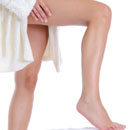Sclerotherapy is used by many doctors to collapse and shrink those veins and restore the appearance of your skin to its original state.
Sclerotherapy has been used by doctors in Europe for over 50 years, but has only become popular in the United States in recent years. Some estimates place half of the adult female population of the US with this unsightly condition. Treatment can significantly diminish the appearance of existing spider veins, however, it cannot prevent new ones from occurring.
Spider veins, also known as varicose veins, telangiectasias, or sunburst varicosities, are tiny veins that lie just below the surface of the skin. They are connected to your larger vein system but aren't necessary for circulation. Spider veins are tiny compared to varicose veins, which are definitely similar, but usually refer to larger veins that bulge and may require a different type of treatment or surgery.
What causes spider veins? Lots of everyday factors contribute to the problem. Some of the common causes are occupational, like standing or sitting for extended periods of time. Other causes can include hormonal imbalance, side effect of medication, rapid weight gain, pregnancy, or simply heredity.
How does sclerotherapy work? The doctor simply injects sclerosing solution into the vein, causing it to shrink and fade from the surface of the skin. Having this treatment can also reduce the symptoms that are commonly associated with spider veins, including, burning, cramping and swelling. It is predictable, effective, and largely pain free. There are very few risks involved, but certain patients have experienced small blood clots that form in the veins, or allergic reactions to the sclerosing solution. Another complication that may occur is a change in pigmentation that takes some time to fade.










